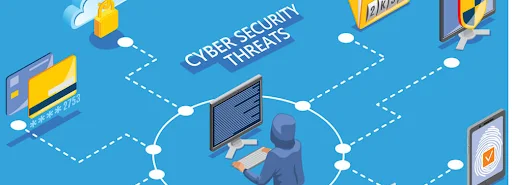Five Types Of Cybersecurity Threats In Business
Today, every business is dealing with different cybersecurity concerns. Before starting your defense mechanism, you need to understand the most common cyber security threats. It's time to know what possible threat your business face in this highly dynamic digital world.
1. Malware
Do you know cybercriminals use malware to attack small businesses?
At 18%, malware is the most common type of cyberattack aimed at small businesses.
Malware is malicious software created to disrupt a computer system or get access to sensitive and confidential information. There are different forms of malware, such as ransomware, spyware, adware, and virus.

Typically, these malware are sent via email attachments or some website links. If you want to protect your organization against malware, you need to install the latest antivirus program, It regularly scans your system against malware. However, this program could be more effective, and you need to have a proactive defense, which comes in the form of EDR - Endpoint Detection and Response.
2. Data Leaks/Breaches
According to UpGuard, the Cost of a Data breach is $4.35 million in 2022, it's almost a 2.6% rise from 2021.
As soon as cybercriminals gain unauthorized access to your company's network, they try to steal your confidential data. You don't know the purpose of this access, but they most commonly get access to customer records, financial information, and trade secrets. They can steal your trade secrets and share them with your competitors.
To prevent Data leaks and Breaches, it's vital to secure your IT infrastructure by implementing robust security protocols. You can install an EDR on the business's endpoint to secure them. If someones try to access your data and information or when there is malicious activity across your network, you'll get an alert.
Another way to protect against unauthorized access is to implement two-factor authentication.
3. Ransomware
It is reported that 82 percent of ransomware attacks happened in 2021, and criminals targeted businesses with less than 1000 employees.- Source
A study states, "In the past year ransomware attacks have increased by almost 13%, an increase as big as the last 5 years combined."
Ransomware is one of the most prevalent cyber security threats. It is a kind of malware that encrypts files on your system and locks it. You won't be able to unlock your system until a ransom is paid. Cybercriminals demand ransom ranging from $500 to one million, depending on the business.
To prevent a ransomware attack, you need to keep a proper backup of your system. So, if your system gets locked and a ransomware attack happens, you can use the backup to restore data.
4. DDoS Attacks
The amount of DDoS Boosted in 2023- Source
Cloudflare reported that Ransom DDoS Attached boosted up to 67 percent.
DDoS stands for Distributed Denial of Service. It is a cyber security threat where multiple computers attack a single server with traffic. The purpose is to overwhelm it and take it offline temporarily. The goal of this attack varies
Some criminals perform this attack to disrupt the business operation. Some competitors plan this attack out of revenge. Other criminals try to extort money through financial business through DDoS. When creating a defense against DDoS, companies need to rely on robust firewalls.
5. Social Engineering
According to a CS Hub Mid Year Market report in 2022, 75 percent of respondents said social engineering is the top cybersecurity threat.
It is a technique where hackers manipulate people and get sensitive information like passwords and account numbers. They use different deception techniques, such as the false promise of rewards and impersonation.
Phishing is a common form of social engineering. Cybercriminals use emails and websites to trick users into revealing sensitive and confidential information such as account info, credit card numbers, financial account details, or passwords. These emails often look like official correspondence from banks or legitimate organizations.
Now the question is how to deal with social engineering. The answer lies in awareness and training. You must educate your employees about all cyber security threats, like how to spot them and how not to fall victim to any social engineering attack.
Wrap up
Cyber security threats are of different kinds. To protect your organization, you need to implement robust security protocols. It would help to educate your employees against common scams and social engineering techniques. It will help you keep your organization well-protected and not become vulnerable just because an employee accidentally opened an email. When you have robust cyber defense, you'll have peace of mind that your business data and trade secrets are fully secure.
Antivirus programs and firewalls alone can't secure your business network if you want to deal with cybersecurity threats at your endpoints. You should install Xcitium EDR, and it won't let cybercriminals have unauthorized access to your system or steal confidential data.
